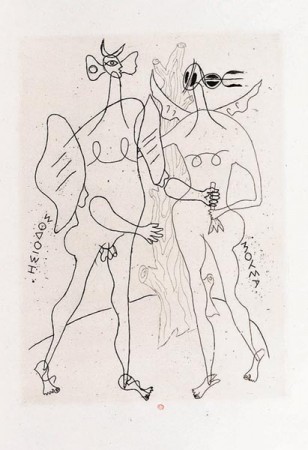Sequel of the preceding post Cosmogenesis (1) : From Myth to Myth
Chaos and Metamorphosis
The ancient Greeks had a great variety of myths relating to the history of the world. Although they all shared a language and a culture, each village, each tribe had its own beliefs, its own version of the Creation story and its own gods who were responsible for cosmic order.

In this illustration by Georges Braque, Hesiod is seen receiving the torch of Hebrew tradition from Moses.
Hesiod, Theogony, Paris, Maeght, 1955.
Hesiod’s Theogony (8th-7th century BC) was the first attempt to synthesize these traditions, which probably dated back to the Assyrian and Babylonian civilizations. In recounting the stages in the emergence of the gods from primordial chaos Theogony offers an answer to the eternal questions of cosmogony: who created the world; what were the basic materials from which it was made; which came first, the gods, the stars or the elements?
Not only did Theogony have a strong influence on Greek thought, it also anticipated in many ways today’s theories of the origin of the world – particularly the idea of primordial chaos. Since the universe appears to have an ordered structure (albeit an imperfect one), it seems logical to regard the state which preceded the Creation as one of disorder and confusion. This notion has provoked greater controversy than almost any other in the history of cosmogony.
Ovid’s Metamorphoses also trawled Greek mythology, as well as Roman legend, in attempting to reconstruct the series of metamorphoses the world had undergone between the original state of Chaos and Julius Caesar’s supposed transformation into a star:
“Before the sea and the lands and the sky that covers all,
there was one face of nature in her whole orb
(they call it Chaos), a rough unordered mass,
nothing except inactive weight and heaped together
the discordant seeds of unassembled things.” [i] Continue reading
